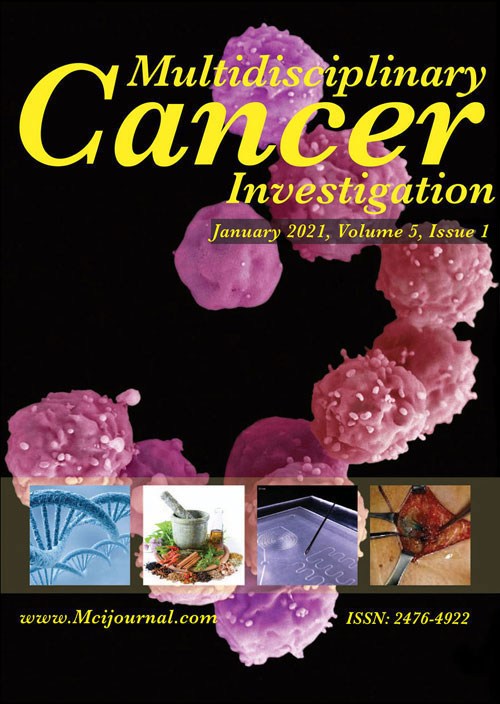فهرست مطالب

Multidisciplinary Cancer Investigation
Volume:7 Issue: 1, Jan 2023
- تاریخ انتشار: 1402/03/08
- تعداد عناوین: 3
-
-
Page 1
Hydrogels are often exploited biological materials in the transfer of biomolecules such as medications, DNA, and proteins owing to apparent features, including cytocompatibility and likeness to genuine human tissues. A number of biomaterials have the capacity to be injected, which allows for minimum invasion and eliminates the necessity of surgery to transplant pre-formed materials. This material is injected through the target location in a solution condition before gelling. If a stimulus generates gelation by the interaction of one or more stimuli, it can do so spontaneously. When such occurs, the material/system is referred to be stimuli-responsive since it reacts to its environment. In this context, we discussed the many triggers leading to gelation and reviewed the various processes by which the solution becomes a gel. We also reviewed several trials that used these gels to treat cancer. These materials show promise for treating cancer. Injectable hydrogels and stimuli-sensitive materials were the topics of several studies and reviews. To our knowledge, there has not been any research done on the use of smart injectable hydrogels for tumor therapy.
Keywords: Injectable, Stimuli Responsive Polymers, Drug Delivery Systems, Neoplasms, Therapeutic -
Page 2Introduction
Radiation therapy (RT) is frequently associated with acute and chronic cutaneous adverse effects. Due to the proximity of breast tissue (as the target of radiation therapy) to the skin, breast cancer patients are at risk of these complications. Some of these adverse effects such as radiodermatitis are much more common and familiar to both the dermatologists and radiotherapists. Conversely, some of the other cutaneous reactions such as radiation-induced lichen planus (LP) as a kind of “isoradiotopic response” are less known, much rarer, and usually misdiagnosed. “Isoradiotopic response” refers to the development of a secondary, unrelated dermatosis in previously irradiated sites. For the first time, this term was used by Shurman et al., (2004) to describe a case of post- radiotherapy LP arising in the genital area two months after RT for penile carcinoma. The LP lesions were completely restricted to the field of RT.
Case presentationWe report the development of localized lichen planus in a 34-year-old female patient who received radiotherapy for invasive ductal carcinoma of the breast. She had no history of prior LP. Her LP lesions developed nine months after the termination of RT and were confined to the radiation field. Her LP lesions responded well to topical corticosteroids. However, after six months, her LP lesions recurred, involving the same area that showed a positive response to the treatment with topical corticosteroids. Over the next few years, she underwent some cosmetic and non-cosmetic surgical procedures, including delayed breast reconstruction with an implant, without Koebner phenomenon induction at surgical incision lines.
ConclusionAlthough radiation-induced LP is a rare complication of RT, it is necessary for clinicians, especially dermatologists and radiotherapists, to be acquainted with it. As more patients with post-radiation LP are reported, investigators will be able to provide more information about the pathogenesis of the disease and evaluate the significance of different factors in its development.
Keywords: Radiotherapy, Lichen Planus, Breast Neoplasms, Radiation, Isoradiotopic Response -
Page 3Introduction
The diagnosis of brain tumors often involves the use of Magnetic Resonance Imaging (MRI), with the Apparent Diffusion Coefficient (ADC) being a commonly employed technique in current clinical practice. This study seeks to investigate the potential of using statistical texture analysis of MRI-ADC images to distinguish between malignant and benign brain tumors.
MethodsThe research utilized 980 MRI brain ADC image slices labeled as malignant and 805 labeled as benign from 252 subjects. The clinical diagnosis of each participant was verified by histopathological and radiological reports. The region of interest (ROI) was defined to extract ADC values within the tumor areas. From each ROI, statistical features including higher-order moments of ADC, mean pixel value, and texture features of Grey Level Co-occurrence Matrix (GLCM) were extracted along with patient demographic information. The mean feature values for each category were computed and analyzed using a one-tailed P value test at a 95% confidence level.
ResultsThe average pixel value of ADC, as well as the GLCM texture features (Variance 1, Variance 2, Mean 1, Mean 2, Contrast, and Energy), were found to be significantly higher (P<0.05) for benign tumors. In Contrast, malignant tumors exhibited significantly higher values for kurtosis of ADC and GLCM texture features (Entropy, Homogeneity, and Correlation). The patient's age and other features (skewness of ADC, GLCM texture features such as Shade, Entropy, and Prominence) did not provide sufficient evidence to reject the null hypothesis (P>0.05).
ConclusionsIn conclusion, the aforementioned features, with the exception of the patient's age, skewness, and GLCM features such as Entropy, Shade, and Prominence can be used as potential biomarkers for distinguishing between benign and malignant brain tumors.
Keywords: Magnetic Resonance Imaging, Malignant Brain Neoplasm, Benign Brain Neoplasm, Diffusion Weighted MRI

